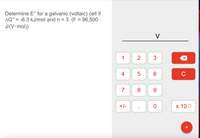
Chemistry
10th Edition
ISBN: 9781305957404
Author: Steven S. Zumdahl, Susan A. Zumdahl, Donald J. DeCoste
Publisher: Cengage Learning
expand_more
expand_more
format_list_bulleted
Question
thumb_up100%

Transcribed Image Text:Determine E° for a galvanic (voltaic) cell if
AG° = -6.3 kJ/mol and n = 3. (F = 96,500
J/(V•mol))
%D
V
1
3
4
6.
C
7
8.
9.
+/-
х 100
+
2.
Expert Solution
This question has been solved!
Explore an expertly crafted, step-by-step solution for a thorough understanding of key concepts.
This is a popular solution
Trending nowThis is a popular solution!
Step by stepSolved in 2 steps with 2 images

Knowledge Booster
Learn more about
Need a deep-dive on the concept behind this application? Look no further. Learn more about this topic, chemistry and related others by exploring similar questions and additional content below.Similar questions
- A certain metal M forms a soluble sulfate salt M₂SO4. Suppose the left half cell of a galvanic cell apparatus is filled with a 2.00 M solution of M₂SO4 and the right half cell with a 10.0 mM solution of the same substance. Electrodes made M are dipped into both solutions and a voltmeter is connected between them. The temperature of the apparatus is held constant at 35.0 °C. Which electrode will be positive? What voltage will the voltmeter show? Assume its positive lead is connected to the positive electrode. Be sure your answer has a unit symbol, if necessary, and round it to 2 significant digits. V left right x10 X Tarrow_forwardQuestion 4: (a) What are redox reactions? Explain the difference between a gal- vanic and an electrolytic cell. Consider the cell described below: Al | AP"(1.00M) | Pb³"(1.00M) | Pb Calculate the cell potential after the reaction has operated long enough for the [Al"] to have changed by 0.60 mol/L. (Assume T = 25°C.) (b) Many elements have been synthesized by bombarding relatively heavy atoms with high-energy particles in particle accelerators. Complete the fol- lowing nuclear equations, which have been used to synthesize elements. U + C-→ Cf + Cf + 'B Lr + + He Bk + in + 6 n 10 Db + 4 in 103arrow_forwardConsider the following voltaic cellat 25°C: Al(s) | Al3*(0.20 M, aq) || Al3+(0.75 M, aq) | Al(s) If the standard reduction potential for the Al3+(aq) /Al(s) redox couple is -1.66 V, what is the overall cell reaction and the cell potential of the voltaic cell shown above? (Reference the cell as written above.) The overall cell reaction is Al3+(0.75 M, aq) AIS*(0.20 M, ag) and E°cell = +0.0113 V. There is no overall cell reaction and E°cell = 0.00 V. The overall cell reaction is Al3+(0.20 M, aq) Als*(0.75 M, aq) and E°cell = +0.0113 V. The overall cell reaction is Al3+(0.20 M, aq) →A13+(0.75 M, ag) and E°cell| = -0.0113 V. The overall cell reaction is Al3*(0.75 M, aq) →AI3*(0.20 M, aq) and E°cell = -0.0113 V. None of thesearrow_forward
- In an car battery recharging occurs when the car is running by supplying a current to the battery. The reaction that occurs at the cathode in this electrolytic process is Pb2+ + 2e- --> Pb (s) If the car supplies a current of 1.50A to the battery, how long will it take in minutes to have 25.0 g of Pb(s) collected at the cathode? Hint: Start with 25.0 g Pb (1A = 1C/sec) (F= 96500 C/mole e-) (Pb =207.2g/mol) Answer has 3 sig figsarrow_forwardhow many minutes are required to produce 8.79 g of aluminum metal from the electrolysis of molten AlCl3 with an electrical current of 15.1 A? F=96470 C/mol e^- 1 A= 1 C/s please do a minimum of 3 sig figsarrow_forwardWhat is the cell potential for the following cell at 25°C?Al ∣ Al3+(0.00212 M) Sn2+(0.435 M) ∣ SnAl3+ + 3 e- → Al(s) E° = -1.676 VSn2+ + 2 e- → Sn(s E° = -0.137 Varrow_forward
- Use the tabulated half-cell potentials to calculate ΔG° for the following reaction. (Hint: Before you being, you must determine whether or not the reaction is balanced.)I2(s) + Fe(s) → Fe3+(aq) + I⁻(aq) (a)‒1.1×102kJ (b) +4.9×101kJ (c) ‒9.7×101kJ (d) ‒3.3×102kJarrow_forward3.A technician is plating a faucet with 1.26 g of Cr from an electrolytic bath containing aqueous Cr2(SO4)3. If 18.5 min is allowed for the plating, what current is needed? Faraday's constant = 96, 485 C/mol . Molar mass Ni = 51.9961 g/mol Group of answer choices 2.10A 1.36A 3.16A 6.31Aarrow_forwardWhat is the equilibrium constant K at 25°C for an electrochemical cell when E° = %3D +0.0290 V andn= 2?(F = 96,500 J/(V· %D mol), R = 8.314 J/(mol·K)) %3D tvarrow_forward
arrow_back_ios
arrow_forward_ios
Recommended textbooks for you
 ChemistryChemistryISBN:9781305957404Author:Steven S. Zumdahl, Susan A. Zumdahl, Donald J. DeCostePublisher:Cengage Learning
ChemistryChemistryISBN:9781305957404Author:Steven S. Zumdahl, Susan A. Zumdahl, Donald J. DeCostePublisher:Cengage Learning ChemistryChemistryISBN:9781259911156Author:Raymond Chang Dr., Jason Overby ProfessorPublisher:McGraw-Hill Education
ChemistryChemistryISBN:9781259911156Author:Raymond Chang Dr., Jason Overby ProfessorPublisher:McGraw-Hill Education Principles of Instrumental AnalysisChemistryISBN:9781305577213Author:Douglas A. Skoog, F. James Holler, Stanley R. CrouchPublisher:Cengage Learning
Principles of Instrumental AnalysisChemistryISBN:9781305577213Author:Douglas A. Skoog, F. James Holler, Stanley R. CrouchPublisher:Cengage Learning Organic ChemistryChemistryISBN:9780078021558Author:Janice Gorzynski Smith Dr.Publisher:McGraw-Hill Education
Organic ChemistryChemistryISBN:9780078021558Author:Janice Gorzynski Smith Dr.Publisher:McGraw-Hill Education Chemistry: Principles and ReactionsChemistryISBN:9781305079373Author:William L. Masterton, Cecile N. HurleyPublisher:Cengage Learning
Chemistry: Principles and ReactionsChemistryISBN:9781305079373Author:William L. Masterton, Cecile N. HurleyPublisher:Cengage Learning Elementary Principles of Chemical Processes, Bind...ChemistryISBN:9781118431221Author:Richard M. Felder, Ronald W. Rousseau, Lisa G. BullardPublisher:WILEY
Elementary Principles of Chemical Processes, Bind...ChemistryISBN:9781118431221Author:Richard M. Felder, Ronald W. Rousseau, Lisa G. BullardPublisher:WILEY

Chemistry
Chemistry
ISBN:9781305957404
Author:Steven S. Zumdahl, Susan A. Zumdahl, Donald J. DeCoste
Publisher:Cengage Learning

Chemistry
Chemistry
ISBN:9781259911156
Author:Raymond Chang Dr., Jason Overby Professor
Publisher:McGraw-Hill Education

Principles of Instrumental Analysis
Chemistry
ISBN:9781305577213
Author:Douglas A. Skoog, F. James Holler, Stanley R. Crouch
Publisher:Cengage Learning

Organic Chemistry
Chemistry
ISBN:9780078021558
Author:Janice Gorzynski Smith Dr.
Publisher:McGraw-Hill Education

Chemistry: Principles and Reactions
Chemistry
ISBN:9781305079373
Author:William L. Masterton, Cecile N. Hurley
Publisher:Cengage Learning

Elementary Principles of Chemical Processes, Bind...
Chemistry
ISBN:9781118431221
Author:Richard M. Felder, Ronald W. Rousseau, Lisa G. Bullard
Publisher:WILEY